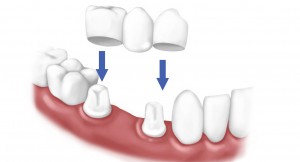Dental bridges are designed to (literally) bridge a gap that exists if you have one or more missing teeth. Bridges are constructed with two or more crowns, which are placed on top of your natural teeth on either side of the gap, and a false tooth (or teeth) in the place of your missing tooth or teeth. The false teeth of your bridge can be made of many different materials, but in most cases they are made of porcelain to match your natural teeth.
Benefits and Types of Bridges
Bridges offer patients several advantages, including the ability to restore your smile and give you the ability to chew and speak properly. They also help to maintain shape for your face and keep other teeth from drifting out of their proper position when there is a gap.
When you come to The Dental Clinic at Roseman University you will receive treatment from highly trained student dentists under the supervision of faculty members who are licensed dentists. These student dentists can provide you with one of several bridge options, including:
- Traditional bridges, which include a crown for one tooth on either side of a missing tooth, and a pontic (or false tooth) in between. These are the most common types of bridges, and are often made of porcelain, in some cases fused with metal or ceramics.
- Cantilever bridges, which are designed to replace a missing tooth where there is only an adjacent tooth on one side. However since the only teeth most people have that only include one adjacent tooth are your molars in the back of your mouth, this type of bridge is not very common. Since the molars have to do a lot of work to chew foods, it puts too much pressure on this type of bridge, which often leads to damage.
- Maryland bonded bridges, sometimes referred to as Maryland bridge or a resin-bonded bridge, which use porcelain or plastic teeth supported by metal or porcelain and are bonded to your existing teeth.
What to Expect
 The process of getting a bridge usually takes place over more than one visit. During the first visit your student dentist will prepare the teeth that are on either side of the bridge (called the abutment teeth) by removing some of the enamel so there is enough room around the edges for the crown to fit over the teeth. Your dentist will take impressions of your mouth so they can fabricate a bridge with new teeth that match your existing ones and fit correctly in the space. Finally, the dentist will install a temporary bridge that protects your teeth while the permanent bridge is made.
The process of getting a bridge usually takes place over more than one visit. During the first visit your student dentist will prepare the teeth that are on either side of the bridge (called the abutment teeth) by removing some of the enamel so there is enough room around the edges for the crown to fit over the teeth. Your dentist will take impressions of your mouth so they can fabricate a bridge with new teeth that match your existing ones and fit correctly in the space. Finally, the dentist will install a temporary bridge that protects your teeth while the permanent bridge is made.
When you return for a second visit, the student dentist removes the temporary bridge and places the new permanent bridge in your mouth. He or she may take some time to adjust it and make sure it fits properly, and you may need to return for additional follow-up appointments to make sure that the bridge fits correctly. After a period of time as it settles and your dentist can see that it is fitting properly, he or she will cement it into place.
Cost of Dental Bridges
At The Dental Clinic at Roseman University you will receive high quality dental care at an affordable price, and while the price of bridges can vary depending on the type of treatment you need and the procedure, our rates are significantly lower than what you would find at a traditional dental clinic.
Patients with private dental insurance may find that some or all of the procedure is covered, but it’s a good idea to call your provide in advance to learn more about the details of your coverage. Our dental clinic cannot bill your insurance directly, but if you have coverage we would be happy to provide you with a detailed explanation of the procedure so you can submit it for reimbursement.
[info_box title=”” image=”” animate=””]Call us today at 801-878-1200 to find out more about the costs of dental bridges and to schedule your appointment.[/info_box]



